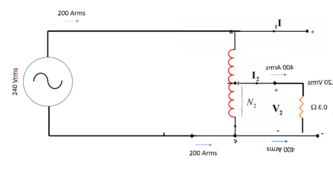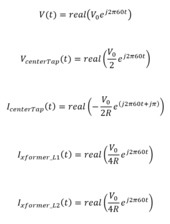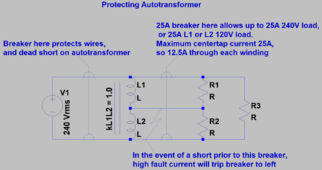Hedges
I See Electromagnetic Fields!
- Joined
- Mar 28, 2020
- Messages
- 20,761
This is entertaining, Hedges, thank you for that.
I can't see it yet but my conceptual understanding of autotransformers is still limited. The diagrams are worth more than words thanks to both diagram drawers.
View attachment 207604
View attachment 207605
I don't see how the first one proves the second one. The first one makes perfect sense to me, and the second one looks wrong. I'm still open to the idea that I just don't understand the second one, and I'll keep trying to see if it clicks somehow.
Edit: Wait the second one only has a load on the 120v? So that makes sense then. What is the big revelation there, if you put 3 amps into a 240v-120v transformer you get 6 amps out, auto or isolation, isn't the question here about what a balanced load is doing?
The two drawings are identical except for amperage values and slight difference in current between the two windings, which I attribute to transformer no-load current; it is an inductor, so carries current based on V = L dI/dt
Phrased the other way, if you put a 6A (720W) load on 120V output of auto-transformer, it draws 3A (720W) from 240V supply. That much is obvious.
Kirchhoff's Law is also obvious.
Given both of those that (almost) everyone should agree on, it is clear that current has to swim upstream in one of the inductor windings. And center tap (neutral) current of auto-transformer is the sum of L1 and L2 current, which are both into the transformer (at the instant N current is out), and both out of the transformer (at the instant N current is in.)
Which gets us back to how transformer should be protected from overload.

Live Ground Shocked 5 Year Old
Excellent work. Thank you so much for your help, you have no idea how much I appreciate it. I have a future project coming up for an offgrid eco friendly glamping site. Do you have any recommendations in terms of inverters to use for this project? just looking to better and consolidate the...
I say that if 25A is the max center-tap N current allowed from transformer, you have to protect L1 and L2 each at 12.5A.
If that breaker is placed between inverter and loads panel with auto-transformer hardwired, only 3kVA total is available whether on one 120V leg, the other 120V leg, or distributed. Safe, but limiting.
Someone might want to just connect auto-transformer through 2-pole 12.5A breaker, but of course you don't want to simply disconnect auto-transformer, leaving split-phase load panel fed from 240V. Lost neutral would cause over and under voltage to loads on each phase.
As safe way to protect from OCP could detect > 12.5A in L or > 25A in N, use that to disconnect inverter from loads panel. 12kVA from two inverters in that case, so 50A max operating current, 63A 2-pole breaker for combined inverter outputs, linked to 12.5A (?) breaker for auto-transformer.
That leaves the question of precisely what OCP value to use. If transformer can handle 12.5A on L1/L2 for 25A on N, a 12.5A breaker could nuisance trip unless continuous load does not exceed 80%, 20A on N. A 15A breaker would allow 25A continuous on N, but transformer might overheat if subject to 30A continuous.
To safely run closer to the limit, I'd prefer a magnetic-hydraulic breaker which doesn't require derating for continuous operation.
Or, use temperature sensor and remote-trip the 63A breaker. That's Victron's implementation. Thermostatic fan, too.





